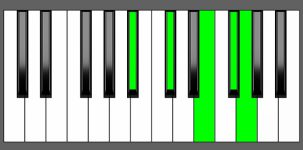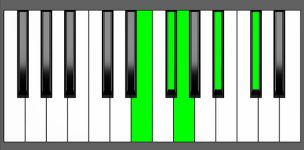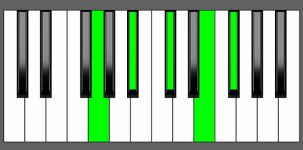Piano Diagram of Gb7b9 in Root Position
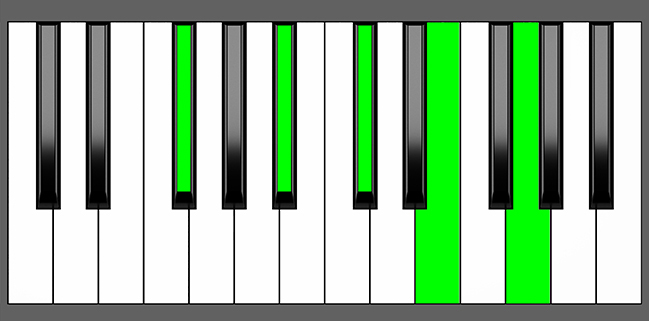
A Gb7b9 chord is an altered dominant seventh chord that is built upon the key of Gb. This chord consists of the root Gb, the major third Bb, the perfect fifth Db, the minor seventh Fb, and the minor ninth Abb. The Gb7b9 chord can be used as a substitute for dominant chords only in specific musical contexts. Keep reading to learn more about the music theory that underpins this chord.
Structure of Gb7b9
Notes |
|---|
| Gb, Bb, Db, Fb, Abb |
Intervals |
|---|
| R, 3, 5, m7, m9 |
How to play a Gb7b9
To play a Gb7b9 chord, you can use the following voicing: start by playing the root note Gb with your left hand. Then, with your right hand, play the notes Bb (major 3rd), Fb (natural E, minor 7th), and Abb (natural G, flat 9th).
Gb + Bb, Fb, Abb
This approach will result in a simplified Gb7b9 chord that includes only the essential notes: the root note, major 3rd, minor 7th, and minor 9th.
Gb7b9 Chord Equivalencies
When you remove the root note from a 7b9 chord, it becomes a diminished 7th chord. In the case of a Gb7b9 chord, if you remove the root note Gb, you’re left with the notes Bb, Db, Fb, and Abb, which are equivalent to a Bbdim7 chord.
Gb7b9 without root = Bbdim7
Bb dim7 = Db dim7 = Fb dim7 = Abb dim7
Diminished 7th chords have a unique quality where each inversion is another diminished 7th chord. So, Bbdim7 is enharmonically equivalent to Dbdim7, Fbdim7 (Edim7), and Abbdim7 (Gdim7). Therefore, even if you remove the root note from a Gb7b9 chord, it is still enharmonically equivalent to all of these chords.
Gb7b9 Chord Inversions
The Gb7b9 chord has a total of 4 inversions:
| Root Position: | Gb | Bb | Db | Fb | Abb |
| 1st Inversion: | Bb | Db | Fb | Gb | Abb |
| 2nd Inversion: | Db | Fb | Gb | Abb | Bb |
| 3rd Inversion: | Fb | Gb | Abb | Bb | Db |
| 4th Inversion: | Abb | Bb | Db | Fb | Gb |
Piano Keyboard Diagrams
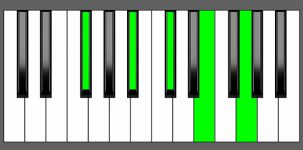
Chord Inversions on Piano
Understanding chord inversions is crucial for music theory, as it reveals how chords are constructed. When playing chord inversions on a piano, it’s important to remember that the charts showing the order of notes may not always be playable.
To properly voice chords on a piano, the notes must be spread across various octaves and positions on the keyboard. This often means deviating from the standard shape of the chord’s inversions, as shown in charts. It’s always a good idea to experiment with different voicings and fingerings to find the most efficient and comfortable way to play the chord, while still maintaining its intended harmonic function and sound.
Chord inversion charts can help understand the structure and sequence of notes in a chord, but it’s important to be flexible and adaptable when playing them on the piano. With practice, you can find your own unique voicings and develop a personal style that suits your playing needs.
Music Theory and Harmony of Gb7b9
The Gb7b9 chord can replace or enhance the Gb7 chord, typically on the V degree, but also on the III degree, and occasionally on other degrees as a secondary dominant chord. However, it has a distinct vibe, so it should be used carefully in the appropriate musical context.
Before delving into the most frequent uses of this chord, let’s first understand how to build it.
Building the Gb7b9 Chord: Different Approaches
Starting from the Gb Major Scale:
To form a 7b9 chord, you combine the root, the major 3rd, the 5th, the minor 7th, and the flat 9th from a major scale.
To build a Gb7b9, you can start with the Gb Major scale:


To create a Gb7b9 chord, apply the formula R, 3, 5, m7, m9 in the following manner:
- Begin with the Root note, which is Gb.
- Select the major 3rd interval, which is Bb, and add it to the chord.
- Add the 5th interval, which is Db.
- Add the minor 7th interval, Fb.
- Finally, select the 9th Ab and subtract a half tone to get the minor 9th, Abb (A double flat).
By following this simple formula, you can create a 7b9 chord from any major scale.
by Combining Intervals:
One method to create a 7b9 chord is by combining specific intervals – a major 3rd, a minor 3rd, and another minor 3rd.
3 + m3 + m3 + m3 = 7b9 chords
For example, to build a Gb7b9 chord:
- we start with the root note Gb.
- We then add a major 3rd interval, which is four half-steps up from the root, to get Bb.
- Next, we add a minor 3rd interval, which is three half-steps up from Bb, to get Db.
- Then, we add another minor 3rd so we find the minor 7th E (Fb)
- and lastly, we add a minor 3rd interval from Fb (E), to get G (Abb).
Together, these intervals form the Gb7b9 chord.
by Combining Chords
Another way to build a 7b9 chord is by combining a major triad with a diminished triad derived from its 5th.
To build a Gb7b9 chord, you can blend a Gb Major triad (Gb, Bb, Db) with a Db diminished chord (Db, Fb, Abb). The Db note is shared between the two chords.
Gb Major + Db dim = Gb7b9
How to Use Gb7b9 in a Chord Progression
The Gb7b9 can work as a substitute or as a passing chord to a Gb7 that can be found in major and natural minor scales. The 7b9 chord is considered a non-diatonic chord, which means that it contains notes that are not found in either the major or minor scales.
Most common uses of Gb7b9
Gb7b9 in Cb Major and Cb minor
The Gb7b9 chord is used as a dominant chord. In the key of Cb major, the Gb7b9 chord can be used as the V7 chord, which leads back to the I chord (Cb major).
However, you’ll never play in Cb major or minor because Cb is a theoretical key, so it’s better to refer to its enharmonic equivalent key B major and B minor.
| Major Scale | I | ii | iii | IV | V | vi | vii |
|---|---|---|---|---|---|---|---|
| Cb = B | B Maj7 | C# min7 | D# min7 | E Maj7 | F#7 ⇒ F#7b9 = Gb7b9 | G# min7 | A#m7b5 |
- Substitute or Passing Chord to the Dominant chord in B Major as F#7b9
Gb7b9 as Substitute of Gbm7
The Gb7 chord derived from the harmonic minor scale is used to replace a Gbm7 chord in the key of Cb minor. In some cases, the Gb7b9 chord can also be used instead of the Gb7 chord, further enhancing the harmonic tension and leading to the Cbm7 chord.
As before, it’s more practical to use F#7b9 in this case because Cb minor is a theoretical key.
| Minor Scale | i | ii | III | iv | v | VI | VII |
|---|---|---|---|---|---|---|---|
| Cb = B | B min7 | C#m7b5 | D Maj7 | E min7 | F#m7 ⇒ F#7 ⇒ F#7b9 = Gb7b9 | G Maj7 | A7 |
- Substitute or Passing Chord to the Dominant chord in B minor as F#7b9
Gb7b9 in a I – III7 Progression
The Gb7b9 chord can be used as a substitution for the III degree in an I – III7 chord progression, which traditionally features a Gb minor chord. This chord progression, represented by the chords Ebb Maj7 and Gb7, can accommodate the Gb7b9 chord in place of the expected Gb minor chord. The Gb7b9 chord provides a dissonant augmented triad that offers a unique flavor to the progression.
Again, Ebb major has a lot of accidentals (is a theoretical key) so we will refer to the equivalent key D major.
| Major Scale | I | ii | iii | IV | V | vi | vii |
|---|---|---|---|---|---|---|---|
| Ebb = D | D Maj7 | E min7 | F#m7 ⇒ F#7 ⇒ F#7b9 = Gb7b9 | G Maj7 | A7 | B min7 | C#m7b5 |
- Substitute or Passing Chord to the Mediant chord in D Major
Gb7b9 in Ab minor
While the Gb7b9 chord can be used in the key of Ab minor, it may not be the most common use of this chord.
| Minor Scale | i | ii | III | iv | v | VI | VII |
|---|---|---|---|---|---|---|---|
| Ab | Ab min7 | Bbm7b5 | Cb Maj7 | Db min7 | Eb min7 | Fb Maj7 | Gb7 ⇒ Gb7b9 |
- Substitute or Passing Chord to the Leading Tone chord in Ab minor (less common)
Gb7b9 as Substitute of a Secondary Dominant 7th chord
A secondary dominant is a chord that doesn’t belong to the main key of a musical piece but is used to create a strong pull toward another chord that does. In Western music, the fifth scale degree has a dominant function and generates tension that resolves to the first scale degree chord (I). A secondary dominant chord is used to create the same dominant function but towards a different chord, resulting in a brief departure from the main key.
For instance, in the key of Fb major, Cb7 is the V chord and resolves to the I chord (Fb Maj7). To create a secondary dominant, another chord is added between Fb Maj7 and Cb7, which creates a powerful pull towards Cb7. In this scenario, incorporating a Gb7 generates a pull towards Cb7 since Gb7 is the V chord in the key of Cb.
| Fb Maj7 | Cb7 |
⇒
| Fb Maj7 | Gb7 | Cb7 |
Instead of using a regular Gb7 chord, you can also use the Gb7b9 chord in place of or together with it. This substitution or addition can add more tension and complexity to the progression, leading to a more interesting and dynamic musical result.
| Fb Maj7 | Cb7 |
⇒
| Fb Maj7 | Gb7/Gb7b9 | Cb7 |
Gb7b9 as Dominant Chord in Cb Major
Gb7b9 as Dominant Chord in B minor
Gb7b9 as III7 Degree in Ebb Major
Gb7b9 as Leading Tone Chord in Ab minor
In the key of Ab minor, the Gb7 chord is built on the leading tone, which is the seventh note of the scale. This chord can be replaced or modulated by a Gb7b9, although it may not be the ideal position for this chord. Nonetheless, it can still be a valid option in certain musical contexts.
| i | ii | III | iv | v | VI | VII |
| Ab min7 | Bbm7b5 | Cb Maj7 | Db min7 | Eb min7 | Fb Maj7 | Gb7 |
Gb7b9 as VII degree – Chord Progressions
i iv VII i
| i | iv | VII | i |
| Ab min7 | Db min7 | Gb7b9 | Gb7 | Ab min7 |
i iv VII III
| i | iv | VII | III |
| Ab min7 | Db min7 | Gb7b9 | Gb7 | Cb Maj7 |
Circle Progression
| i | iv | VII | III | VI | ii | V7 | i |
| Ab min7 | Db min7 | Gb7b9 | Gb7 | Cb Maj7 | Fb Maj7 | Bbm7b5 | Eb7 | Ab min7 |
Alternative Gb7b9 Nomenclature
- Gb 7b9
- Gb 7/b9
- Gb 7(b9)
- Solb 7/b9
- Gb dom7b9
- Gb 7th b9th
- Gb 7th flat 9th
- Gb Dominant 7th b9
- Gb Dominant Seventh Flat Ninth
